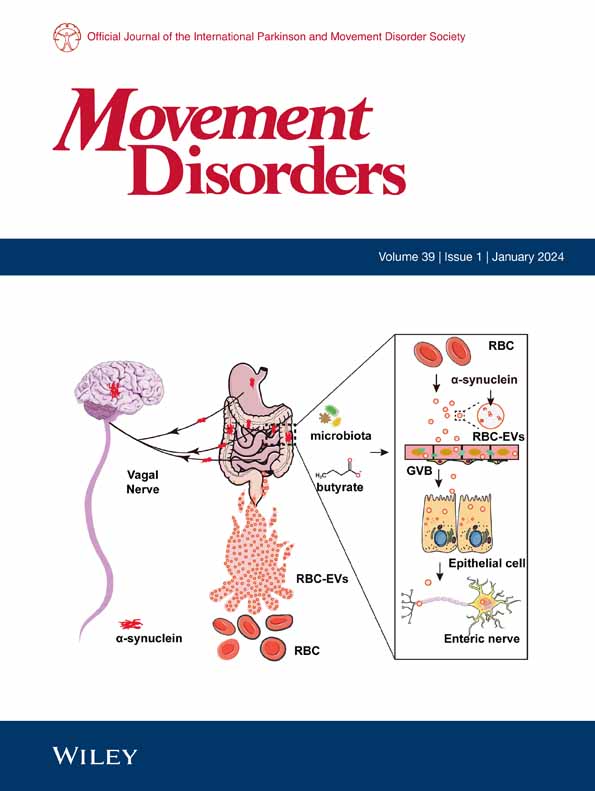NLX‐112 Randomized Phase 2A Trial: Safety, Tolerability, Anti‐Dyskinetic, and Anti‐Parkinsonian Efficacy
IF 7.4
1区 医学
Q1 CLINICAL NEUROLOGY
Per Svenningsson, Per Odin, Filip Bergquist, Karin Wirdefeldt, Dag Nyholm, Mattias Andréasson, Ioanna Markaki, Anders C. Johansson, Måns Jergil, Christopher Jankosky, Mark A. Varney, Fabienne Herbrecht, Steven A. Johnson, Adrian Newman‐Tancredi
求助PDF
{"title":"NLX‐112 Randomized Phase 2A Trial: Safety, Tolerability, Anti‐Dyskinetic, and Anti‐Parkinsonian Efficacy","authors":"Per Svenningsson, Per Odin, Filip Bergquist, Karin Wirdefeldt, Dag Nyholm, Mattias Andréasson, Ioanna Markaki, Anders C. Johansson, Måns Jergil, Christopher Jankosky, Mark A. Varney, Fabienne Herbrecht, Steven A. Johnson, Adrian Newman‐Tancredi","doi":"10.1002/mds.30175","DOIUrl":null,"url":null,"abstract":"BackgroundLevodopa‐induced dyskinesia (LID) in Parkinson's disease (PD) is associated with ‘false neurotransmitter’ release of dopamine from serotonin (5‐HT) neurons. NLX‐112 is a first‐in‐class, highly selective 5‐HT<jats:sub>1A</jats:sub> receptor agonist which counteracts LIDs in experimental PD models.ObjectivesThe primary objective was to evaluate the safety and tolerability of NLX‐112 compared with placebo in people with PD. The secondary objective was to assess the preliminary efficacy of NLX‐112 in reducing LID and its effects on PD symptoms.MethodsParticipants received NLX‐112 or placebo (2:1 ratio) alongside stable Parkinson's medications, with 22 participants completing the study. Dosing was up‐titrated over 28 days to 2 mg/day (1 mg twice daily), stabilized for 14 days (to day 42), and down‐titrated for 14 days. Efficacy was measured using the Unified Dyskinesia Rating Scale (UDysRS), Unified Parkinson's Disease Rating Scale (UPDRS), and Clinical Global Impression of Change (CGI‐C) following a levodopa challenge (150% of usual dose).ResultsAdverse events (AEs) were mainly central nervous system (CNS)‐related and mostly occurred during up‐titration, with no serious AEs in the NLX‐112 group. There were no treatment‐induced clinically significant changes in vital signs, electrocardiogram, or laboratory parameters. NLX‐112 reduced LID from baseline levels: at day 42, UDysRS total score decreased by 6.3 points, whereas placebo group changes were not significant (−2.4). NLX‐112 also reduced parkinsonism from baseline values: UPDRS Part 3 scores decreased by 3.7 points, whereas placebo group changes were non‐significant (+0.1). In CGI‐C assessment, the NLX‐112 group showed greater improvement than the placebo group (53% vs. 29%).ConclusionThese results support further clinical investigation of NLX‐112 for treatment of PD LID. © 2025 Neurolixis SAS. <jats:italic>Movement Disorders</jats:italic> published by Wiley Periodicals LLC on behalf of International Parkinson and Movement Disorder Society.","PeriodicalId":213,"journal":{"name":"Movement Disorders","volume":"90 1","pages":""},"PeriodicalIF":7.4000,"publicationDate":"2025-03-17","publicationTypes":"Journal Article","fieldsOfStudy":null,"isOpenAccess":false,"openAccessPdf":"","citationCount":"0","resultStr":null,"platform":"Semanticscholar","paperid":null,"PeriodicalName":"Movement Disorders","FirstCategoryId":"3","ListUrlMain":"https://doi.org/10.1002/mds.30175","RegionNum":1,"RegionCategory":"医学","ArticlePicture":[],"TitleCN":null,"AbstractTextCN":null,"PMCID":null,"EPubDate":"","PubModel":"","JCR":"Q1","JCRName":"CLINICAL NEUROLOGY","Score":null,"Total":0}
引用次数: 0
引用
批量引用
Abstract
BackgroundLevodopa‐induced dyskinesia (LID) in Parkinson's disease (PD) is associated with ‘false neurotransmitter’ release of dopamine from serotonin (5‐HT) neurons. NLX‐112 is a first‐in‐class, highly selective 5‐HT1A receptor agonist which counteracts LIDs in experimental PD models.ObjectivesThe primary objective was to evaluate the safety and tolerability of NLX‐112 compared with placebo in people with PD. The secondary objective was to assess the preliminary efficacy of NLX‐112 in reducing LID and its effects on PD symptoms.MethodsParticipants received NLX‐112 or placebo (2:1 ratio) alongside stable Parkinson's medications, with 22 participants completing the study. Dosing was up‐titrated over 28 days to 2 mg/day (1 mg twice daily), stabilized for 14 days (to day 42), and down‐titrated for 14 days. Efficacy was measured using the Unified Dyskinesia Rating Scale (UDysRS), Unified Parkinson's Disease Rating Scale (UPDRS), and Clinical Global Impression of Change (CGI‐C) following a levodopa challenge (150% of usual dose).ResultsAdverse events (AEs) were mainly central nervous system (CNS)‐related and mostly occurred during up‐titration, with no serious AEs in the NLX‐112 group. There were no treatment‐induced clinically significant changes in vital signs, electrocardiogram, or laboratory parameters. NLX‐112 reduced LID from baseline levels: at day 42, UDysRS total score decreased by 6.3 points, whereas placebo group changes were not significant (−2.4). NLX‐112 also reduced parkinsonism from baseline values: UPDRS Part 3 scores decreased by 3.7 points, whereas placebo group changes were non‐significant (+0.1). In CGI‐C assessment, the NLX‐112 group showed greater improvement than the placebo group (53% vs. 29%).ConclusionThese results support further clinical investigation of NLX‐112 for treatment of PD LID. © 2025 Neurolixis SAS. Movement Disorders published by Wiley Periodicals LLC on behalf of International Parkinson and Movement Disorder Society.
NLX - 112随机2A期试验:安全性、耐受性、抗运动障碍和抗帕金森病疗效
背景:帕金森病(PD)中左旋多巴诱导的运动障碍(LID)与血清素(5‐HT)神经元释放多巴胺的“假神经递质”有关。NLX - 112是一种一流的高选择性5 - HT1A受体激动剂,可在实验性PD模型中抵消lid。主要目的是评估NLX - 112与安慰剂在PD患者中的安全性和耐受性。次要目的是评估NLX‐112降低LID的初步疗效及其对PD症状的影响。方法:参与者接受NLX‐112或安慰剂(2:1比例)以及稳定的帕金森药物治疗,22名参与者完成了研究。剂量在28天内上升至2mg /天(1mg每日两次),稳定14天(至第42天),下降14天。使用统一运动障碍评定量表(UDysRS)、统一帕金森病评定量表(UPDRS)和左旋多巴刺激(常规剂量的150%)后的临床总体变化印象(CGI‐C)来测量疗效。结果不良事件(ae)主要与中枢神经系统(CNS)相关,主要发生在上滴定期间,NLX - 112组无严重ae。没有治疗引起的生命体征、心电图或实验室参数的临床显著变化。NLX‐112从基线水平降低了LID:在第42天,UDysRS总分下降了6.3分,而安慰剂组的变化不显著(- 2.4分)。NLX‐112也从基线值降低了帕金森病:UPDRS第3部分得分下降了3.7分,而安慰剂组的变化不显著(+0.1)。在CGI‐C评估中,NLX‐112组比安慰剂组表现出更大的改善(53%对29%)。结论:这些结果支持NLX‐112治疗PD - LID的进一步临床研究。©2025 Neurolixis SASWiley期刊有限责任公司代表国际帕金森和运动障碍学会出版的《运动障碍》。
本文章由计算机程序翻译,如有差异,请以英文原文为准。
来源期刊
期刊介绍:
Movement Disorders publishes a variety of content types including Reviews, Viewpoints, Full Length Articles, Historical Reports, Brief Reports, and Letters. The journal considers original manuscripts on topics related to the diagnosis, therapeutics, pharmacology, biochemistry, physiology, etiology, genetics, and epidemiology of movement disorders. Appropriate topics include Parkinsonism, Chorea, Tremors, Dystonia, Myoclonus, Tics, Tardive Dyskinesia, Spasticity, and Ataxia.

 求助内容:
求助内容: 应助结果提醒方式:
应助结果提醒方式:


